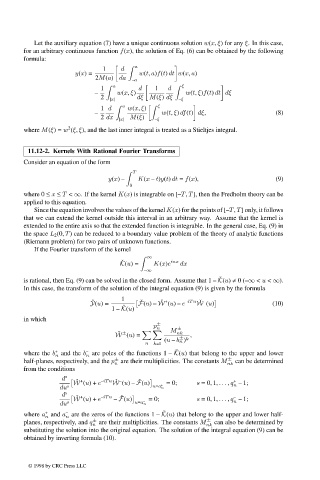Page 593 - Handbook Of Integral Equations
P. 593
Let the auxiliary equation (7) have a unique continuous solution w(x, ξ) for any ξ. In this case,
for an arbitrary continuous function f(x), the solution of Eq. (6) can be obtained by the following
formula:
a
1 d
y(x)= w(t, a)f(t) dt w(x, a)
2M(a) da –a
a ξ
1 d 1 d
– w(x, ξ) w(t, ξ)f(t) dt dξ
2 |x| dξ M(ξ) dξ –ξ
a ξ
1 d w(x, ξ)
– w(t, ξ) df(t) dξ, (8)
2 dx |x| M(ξ) –ξ
2
where M(ξ)= w (ξ, ξ), and the last inner integral is treated as a Stieltjes integral.
11.12-2. Kernels With Rational Fourier Transforms
Consider an equation of the form
T
y(x) – K(x – t)y(t) dt = f(x), (9)
0
where 0 ≤ x ≤ T < ∞. If the kernel K(x) is integrable on [–T, T], then the Fredholm theory can be
applied to this equation.
Since the equation involves the values of the kernel K(x) for the points of [–T, T] only, it follows
that we can extend the kernel outside this interval in an arbitrary way. Assume that the kernel is
extended to the entire axis so that the extended function is integrable. In the general case, Eq. (9) in
the space L 2 (0, T) can be reduced to a boundary value problem of the theory of analytic functions
(Riemann problem) for two pairs of unknown functions.
If the Fourier transform of the kernel
∞
ˇ
K(u)= K(x)e iux dx
–∞
ˇ
is rational, then Eq. (9) can be solved in the closed form. Assume that 1 – K(u) ≠ 0(–∞ < u < ∞).
In this case, the transform of the solution of the integral equation (9) is given by the formula
1
ˇ
ˇ
ˇ +
Y(u)= F(u) – W (u) – e –iT u ˇ – (10)
W (u)
ˇ
1 – K(u)
in which
p ±
n
M ±
W (u)= nk ,
ˇ ±
± k
(u – b n )
n k=1
ˇ
+
–
where the b and the b are poles of the functions 1 – K(u) that belong to the upper and lower
n
n
±
half-planes, respectively, and the p are their multiplicities. The constants M nk can be determined
±
n
from the conditions
s
ˇ +
d –iT u ˇ – +
ˇ
W (u)+ e W (u) – F(u) u=a + =0; s =0, 1, ... , q – 1;
n
du s n
s
d ˇ + –iT u ˇ –
W (u)+ e – F(u) u=a – =0; s =0, 1, ... , q – 1;
n
du s n
ˇ
+
–
where a and a are the zeros of the functions 1 – K(u) that belong to the upper and lower half-
n
n
±
planes, respectively, and q are their multiplicities. The constants M nk can also be determined by
±
n
substituting the solution into the original equation. The solution of the integral equation (9) can be
obtained by inverting formula (10).
© 1998 by CRC Press LLC
© 1998 by CRC Press LLC
Page 576

